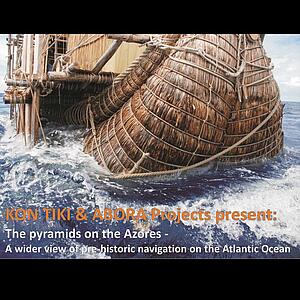The pyramids on the Azores - lecutre by keynotes speaker Dr. Görlitz
The new discoveries
The Azorean archipelago was discovered uninhabited by the Portuguese about 1427. It is widely accepted that the colonization did not start before the middle of the 15th century. However, after findings of ancient Roman coins on the Island Corvo in the 17th century, some historians suggested that the Azores were already discovered much earlier by the Phoenicians. In antique times, there existed cartographical descriptions about remote islands in the Atlantic Sea by many authors like Diodor, Plinius or Strabo. Given the evidence of the mapping of North and South America, those islands would also have been known.
In the last three years, the president of the Portuguese Association of Archaeological Research, Nuno Ribeiro, has been claiming that archeological remains of structures discovered on several Azorean islands are of pre-Portuguese origin. Together with the Portuguese archaeologist Anabela Joaquinito, he has identified dozens of similar pyramidal structures in the Madalena area of Pico Island. Artifacts were also found on site which may predate the Portuguese settlement on the island. They believe the structures may have been built according to an oriented plan, aligned with the summer solstices, which suggests they were built with an intended purpose. They also believe that the Madalena pyramidal structures are analogous to similar prehistoric structures found in Sicily, North Africa and the Canary islands which are known to have served ritual purposes.
The importance for Thor Heyerdahl’s legacy
When Thor Heyerdahl presented the stepped pyramids of Güimar in the media, he received a lot of criticism by the archaeologists, especially from Spain and the Canary Islands. Contrary to the Azores, the Canary Islands were inhabited by natives called "Guanches". The Guanches were living rather primitively at a Stone Age level. Therefore, the archaeologists believed that the pyramidal structures were erected much later by Spanish farmers who cleared volcanic rock stones from their fields. This opinion was supported by the lack of any datable archaeological objects.
However, these scholars completely missed written records of European historians like Leonardo Torriani (1585) or George Glass (1764) who reported that the Guanches made large stepped pyramids by rock stones for ritual purposes. Torriani even described the existence of similar architectural structures in both archipelagos: the Azores and the Canary Islands.
The new pyramid discoveries on the Azores deliver important archaeological evidence for the authenticity of the pyramids on the Canary Islands. They were obviously made long before the discovery of the Canarias by Portuguese seafarers. The architectural concept and archaeological similarities between the pyramids at the Azores and the Canary Islands are impressive. This clearly supports the conclusions of Thor Heyerdahl and it is in line with antique written records. Recent additional archaeological findings, such as Carthaginian sanctuaries, cave art, and megalithic structures, in the Azores by APIA supports the theory of earlier human occupation of the Azores. The combined findings indicate that cultural interactions across the Atlantic Ocean were much more intensive and have happened much earlier than is commonly accepted today.
The KON TIKI Museum Oslo appreciates that Keynote Speaker Dr. Dominique Görlitz from the speakers bureau Global Topspeakers, who has worked in this field for many years, is presenting these new facts and how they are adding to the legacy of Thor Heyerdahl in his 100th anniversary.
More information: www.kon-tiki.no or www.abora.eu

